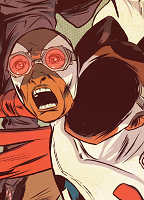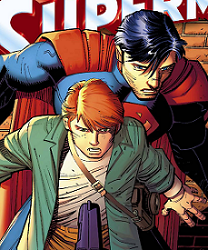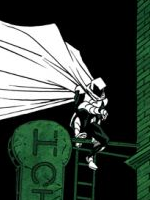Deadshirt Is Reading… is a weekly feature in which Deadshirt’s staff, contributing writers, and friends-of-the-site offer their thoughts on Big Two cape titles, creator-owned books, webcomics and more. For more of our thoughts on this week’s new comics, take a look at Wednesday’s Deadshirt Comics Shopping List.
Max Robinson is reading…
Written by Geoff Johns
Art by John Romita Jr. (pencils) and Klaus Janson (inks)
Colored by Hi-Fi
DC Comics
“Superman’s human for a day?”
Geoff Johns’ final issue of his run on Superman also happens to be the best issue of his run so far and is, truly, one of the best Superman stories I’ve ever read. Picking up right after last issue, wherein temporarily powerless Clark revealed his dual identity to best friend Jimmy Olsen, “24 Hours” poses an obvious but to my knowledge largely unexplored question: Can Superman still be “Superman” even when he’s lost his powers? Can he still do his job with the same limits the rest of us have?
Johns’ exploration is succinct and to the point, culminating with a human Man of Steel placing himself in the middle of a hostage situation. There isn’t a “twist” here, I’m not spoiling anything by saying that even without his abilities, Superman stops the bad guy. But, for whatever valid criticism there is of Johns and his penchant for violence, this is a comic in which Superman uses his brain, his heart, and his unflappable faith in human decency to save lives. It’s suspenseful, it’s moving; it’s everything you could want from this title, and a reminder of who Superman/Clark Kent/Kal-El is, what he stands for.
The heavy, brutal lines of John Romita Jr’s art have grown on me since he began art chores on Superman and, aside from some dips into the uncanny valley with the size of Jimmy Olsen’s head, he lays down some really nice pages here. The book’s centerpiece, a “sideways” splash page of Superman and Jimmy scarfing down a cheap dinner on top of the Daily Planet, was a really inspired way to present a scene we’ve seen many times before in superhero comics.
Even though it’s bookended by some vaguely ominous developments with background villain The Machinist, “24 Hours” stands well on its own as a refreshingly introspective done-in-one adventure for comics’ first and best superhero.
Joe Stando is reading…
 Captain America and the Mighty Avengers #6
Captain America and the Mighty Avengers #6
Written by Al Ewing
Art by Luke Ross and Rachelle Rosenberg (colors)
Lettered by Travis Lanham
Marvel
“Well. Auntie Monica’s not ☠☠☠☠ laughing.”
One of the strengths of Mighty Avengers has been how it pulls from a lot of disparate corners of the Marvel universe with its roster, but still manages to weave everything together in a coherent package. That tendency might be put to the test this week, with the reveal that antagonists Cortex Incorporated are actually the Beyond Corporation, the villains of Warren Ellis’ popular-yet-polarizing Nextwave series. As a jokey, tongue-in-cheek book in an era when Marvel focused heavily on continuity and house tone, it’s been explained away as dubiously canon a number of times, with characters and personalities from the book only carrying over sporadically to others. Ewing seems to place the events of Nextwave directly into continuity, using the “altered memories and personalities” line that’s been floated in various backmatter. At the same time, he’s reinvented Beyond as something very different from the satirical villains of the original series.
It’s all sort of confusing, and I don’t know if they would’ve pulled it off had Ewing and Ross not done such a good job of making Cortex and Beyond absolutely terrifying. The nightmarish eldritch quality of their backstory is an exclamation point on the creepiness that’s been building in the book so far, and the imagery of Jason Cortex and other characters with empty holes for faces is stuff I won’t soon forget. There’s still the characteristic humor here (W.E.S.P.E. are hilarious as usual, and even the Beyond Corporation premise is a bit of a meta-commentary on “what counts” in continuity) but this definitely feels like a turning point for the arc. I’m not quite as taken with the B-plot, since we’ve seen “heroes become out of control villains” riffed on a couple times, both here and in AXIS. The fact that almost all of the Mighty Avengers’ roster is involved, though, is pointing towards a pretty insane final showdown, and the final page, in which Spectrum seemingly reverts to her unstable Nextwave persona, is pretty tantalizing as well.
Jason Urbanciz is reading…
Written by Gilbert Hernandez, Amy Chu, Lauren Beukes & Dale Halvorsen and Ivan Brandon
Art by Gilbert Hernandez, Tana Ford, Christopher Mitten and Amei Zhao
Colored by Trish Mulvihill, Giulia Brusco, Eva De La Cruz and Amei Zhao
Lettered by Pat Brosseau, Sal Cipriano, Dezi Sienty and Clem Robins
Vertigo
“No one gets left behind for baseball.”
For a few years now, Vertigo has been periodically reviving old DC Comics titles as anthologies to bring in classic creators and to give some new ones a chance to show off. Anthologies are by their nature hit and miss, and this title is no different, but the hit makes up for some (slight) misses. First up is the gem of the issue, by Love & Rockets creator Gilbert Hernandez. A group of boys find a ball that falls to Earth, and soon one of them is whisked off to a Martian slave ship for thirty years, returning minutes later as a much older man. From there, the boys conspire to give a bully his comeuppance and return their friend to his youth. It’s a goofy, fun, story and Hernandez’s clean, bright art gives it the look of a lost episode of The Twilight Zone.
The next two stories that follow give the sports of dodgeball and hockey a bloody, sci-fi spin, and both are perfectly fine, but they ditch the goofiness of the first one in favor of blood, gore, and “shocking twists” that land well but still leave the stories feeling slight. I did really dig Tana Ford’s art on the dodgeball story set in a space prison. She was able to invest her characters with a lot of life in only a few pages, and I’ll definitely be on the look out for her name again.
The final story features a couple who were breaking up as the world ended, fleeing New York by boat as the city burns, eventually drifting all the way to Cuba, where they attend the final baseball game. Told mostly in first person by the unnamed woman in the couple, it’s an interesting meditation that at even the worst times, be it a break-up or the actual end of the world, baseball can still be a source of joy.
While none of the stories hit the highs of the Hernandez story, I think that’s more my fault than the stories’. I was hoping for more Silver Age-style goofiness out of the comic and the first story delivered, while the others were more “modern” in their sensibilities. That’s fine, just not what I wanted. I’m glad that Vertigo keeps pushing out these anthologies because there’s always something rewarding in each of them.
Kayleigh Hearn is Reading….
Written by Cullen Bunn
Art by Ron Ackins
Lettered by Travis Lanham
Marvel
“You know how I feel about ghosts.”
Moon Knight and Magneto are characters I’ve never thought to compare before—they occupy very different corners of the Marvel Universe, and one is the “Master of Magnetism” while the other has often been referred to, not always kindly, as “Marvel’s Batman.” Even their costumes (Magneto’s is jet black, Moon Knight’s is bone white) suggest they’re more likely to be seen as stark contrasts to one another. And yet when I saw that Cullen Bunn, the writer of the dark, psychologically piercing Magneto solo series, was starting a new arc on Moon Knight, I thought, “of course!” He’s already done good work on one intensely driven, mercenary anti-hero, so what a fitting choice to take on the tortured psyche of Marc Spector.
Moon Knight #13 is a strong entry point for the series, mixing superhero action with supernatural themes. Moon Knight, the “Guardian of nighttime travelers,” finds his home suddenly haunted by sick, silent ghosts, and the moon god Khonshu prods the reluctant hero to find the source of their pain. It’s a very common set-up in supernatural fiction, but the explanation—creeps are sealing spirits in Pokéball-like “Witch’s Orbs” to sell on the black market—gives the plot enough of a contemporary twist. Anything can be commodified in today’s society, even the spirits of the dead.
Bunn and artist Ron Ackins craft a compelling issue that’s heavy on mood and atmosphere rather than plot. Ackins’s artwork is appropriately creepy, especially when his visuals include ghostly abandoned hotels and mysterious bloody footprints. His action sequences unfortunately come across as unclear and confusing, but it’s not enough to derail the issue. Watching Moon Knight’s white costume become increasingly bloody and grimy as he battles his way through a meat packing plant is powerful. Moon Knight #13 is a creepily good first issue for a new creative team that is well-suited to the character, and it’s worth a read. Just follow the bloody footprints.
Thanks for reading about what we’re reading! We’ll be back next week with a slew of suggestions from across the comics spectrum. In the meantime, what are you reading? Tell us in the comments section, on Twitter or on our Facebook Page!




